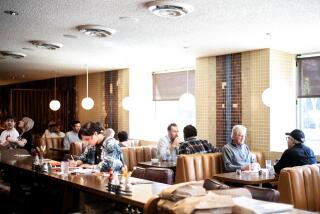A behind-the-scenes look at Dry River Brewing in Boyle Heights
On an afternoon in February, Naga Reshi, the brewmaster at Dry River Brewing Co. in Boyle Heights, pilots a forklift laden with 250 gallons of his next batch of beer down the street to his brewery. Most brewers work in their own brewhouse — they simply need to hook up a hose and pump liquid from the brewhouse to a stainless steel fermenter. Dry River Brewery does things a little differently.
Tucked into the warehouses between the Los Angeles River and the 101 Freeway in Boyle Heights, Dry River Brewery lacks a production brewhouse — the assembly of vats, kettles and plumbing where brewers typically begin the beer-making process. Instead, Reshi brews the wort — the sweet liquid that becomes beer once yeast gets hold of it — for his beer at another Boyle Heights craft brewery, Indie Brewing Co. The Indie Brewing Co. production facility and taproom is about 100 feet from Dry River, but it’s 100 feet strewn with potholes, unused railroad tracks and just enough commercial traffic to make the voyage stressful. “Anything can happen out there,” says Reshi, who has worked in breweries from Alaska to Brazil, making about every style of beer imaginable.
Collaboration is commonplace in the craft beer industry, but every Dry River brew day takes cooperation. Reshi brews a batch at Indie Brewing Co. about once a month, and when the brewing is done, the wort is cooled to a yeast-friendly temperature (about 70 degrees) and pumped into a movable plastic vat enclosed in a metal cage, called a tote. Then, instead of fermenting the beer in the typical temperature-controlled stainless steel tanks, all of Dry River’s beers are fermented and conditioned in used wine barrels.
Reshi and James Mancuso, Indie Brewing’s head brewer, collaborated on a brew with Travis Tolson, who runs the Wicked Weed Brewery in Asheville, N.C. Tolson worked as cellarman (the low man in the hierarchy at a brewery) under Reshi at Alaska’s Kodiak Island Brewery, and they became fast friends. The brewers collectively created a beer in Asheville in January called Calilina — a portmanteau of California and Carolina. It’s a farmhouse ale that pairs a variety of heritage grains with blueberries and lemongrass green tea. Tolson visited L.A. to brew another batch on the West Coast.
The persimmon-hued Calilina deftly balances a robust yeast-driven aroma with a complex cereal character and just enough berry and lemongrass flavors. Tannins from the green tea and a dry finish underscore the thirst-quenching character of the brew. “Come summer, I could crush this all day long,” says Tolson.
The West Coast version is nearly the same recipe, but the final product will differ greatly in flavor. At Dry River the brew was fermented in four oak wine barrels with the brewery’s house blend of yeasts and bacteria before moving into different barrels, with blueberries added for a longer secondary fermentation. Now the waiting begins, and once the microbes have had their way with the brew, Reshi says that the Dry River version of Calilina should be softly tart and funky with some oak character.
Reshi’s true passion is the complex and finicky world of mixed fermentation: beer that employs wild yeasts, bacteria and long fermentations, or what he calls slow beer.
True to Dry River’s mantra of “slow beer,” Calilina won’t be ready until “late fall,” Reshi says. “Maybe.”
Soon L.A.’s beer fans will be able to taste some of the other Dry River beers on-site in Boyle Heights. Once the permits are approved, Dry River will be open to the public for tastings and bottle sales, but there are no plans to add more on-site brewing capability.
Until then, you can find Dry River beers at craft beer bottle shops such as Sunset Beer Co. in Echo Park and Craft Beer Cellar in Eagle Rock, or at bars and restaurants such as Bestia in the Arts District, Bar Bandini in Echo Park and the Cannibal in Culver City.
671 S. Anderson St., Los Angeles, (213) 375-5235, www.dryriverbrewing.com.
ALSO:
More to Read
Eat your way across L.A.
Get our weekly Tasting Notes newsletter for reviews, news and more.
You may occasionally receive promotional content from the Los Angeles Times.






